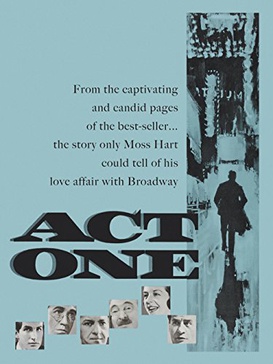
It’ll be a day or two until my next book review. I’m reading Act One, the autobiography of Moss Hart, the renowned Broadway playwright and director. It came up as a bargain e-book on Amazon, and it’s about two things I like – writing and the theater. It is an interesting book, and I’ll have much to say about it when I’ve finished reading.
The book was made into a biographical movie in 1963. I didn’t see it, of course (we rarely saw movies in our family), but I caught part of it on TV at some point over the years. My perception of the film (which got mediocre reviews) is marked by an article I saw in Parade Magazine at the time of the release. At least I’m pretty sure the article was about this movie. There’s a scene that exactly corresponds to what it described.
According to the article, when they were casting the parts of famous people who only appear briefly, they hired some of those people’s actual children to play them. I’m pretty sure a son of Robert Benchley played him in the scene where there’s a gathering in George S. Kaufman’s apartment. (Might have been Nathaniel, but I can find no mention of it online). There were others as well — I forget who. IMDb says nothing about this casting gimmick, but I like to believe I remember correctly.
There’s a formula in the movie business, I read somewhere: “When you’re casting famous real-life characters, the smaller the part, the more they must resemble the person they’re playing.”
That sounds paradoxical, but it makes sense in practice. When you’re dealing with a lead, you’ve got the whole length of the production to convince the audience that (taking an example purely at random) Kyle MacLachlan is Franklin Roosevelt. But when you bring somebody on for a minute as, oh, Humphrey Bogart, you don’t want the viewer to be diverted from following the story to ask, “Is that supposed to be Bogey?”
The movie that jumps to my mind when I consider this rule is “The Plainsman,” a 1936 film by Cecil B. DeMille, which stars Gary Cooper as Wild Bill Hickok. Except in height, Coop bears no resemblance whatever to Hickok. His nose is the wrong shape, his hair is way too short, and there’s no mustache at all (Hollywood, after World War I, adopted a long-standing tradition of erasing almost all mustaches from historical characters. Only the Hippie Era shook them off it). But Buffalo Bill Cody wears the proper long hair and imperial goatee. As does General Custer.
I’m not sure how they managed to preserve Buffalo Bill’s beard and hair style in 1944’s movie, “Buffalo Bill,” starring Joel McCrae. But they got away with it. I suppose Buffalo Bill’s appearance was so iconic they couldn’t escape it.
Note to future producers: If a movie is ever made of my life, you have my permission to cast somebody thinner and taller to play me. But you need to keep the pigtail in the older scenes.
